If your team struggles to stay aligned across locations, departments, or shifts, the right intranet software can bring everyone together in one connected workspace.
With scattered tools, remote teams, and growing complexity, important updates often go unnoticed, and collaboration falls apart. That’s where intranet software comes in.
It brings everything—chat, docs, directories, updates—into one place, so your business runs smoothly and your people stay in sync.
In this guide, we review the 5 best intranet software tools in 2025, including:
Our Top Picks
-
1
Best all-in-one intranet software
-
2

Good for AI-powered employee engagement
-
3

Good for large enterprises
Why trust us?
Our team of unbiased software reviewers follows strict editorial guidelines, and our methodology is clear and open to everyone.
See our complete methodology
What to Look For in a Intranet Software
Here’s what I looked for when choosing the best intranet software:
Must-have features
- Centralized knowledge base: The software should be able to store and manage important company documents and information in one central location.
- Company directory: It should be easy to search for and contact the right team member.
- Built-in chat: The tool must allow teams to communicate in real-time.
- Search functionality: Employees should be able to easily access company information with a quick search.
- Access control: Admins should be able to set custom permissions and control access to sensitive information.
I also made sure the software is:
- User-friendly, so employees can start using it right away.
- Affordable, so businesses of all sizes can use it as they grow.
Finally, I checked for features that make intranet software stand out:
- Mobile accessibility, to allow employees to receive updates and information on the go.
- Integrations to fit seamlessly with the business tools you already use.
The 5 Best Intranet Software of 2025
-
Connecteam — Best All-in-One Intranet Software
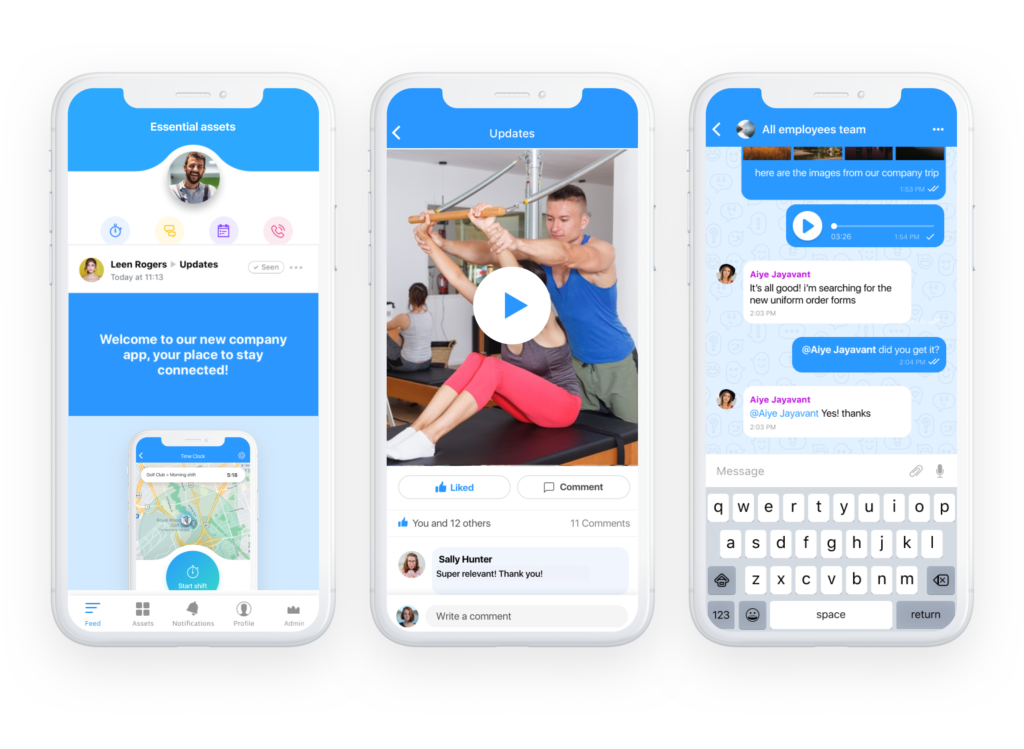
Connecteam is an all-in-one work management platform and the best intranet solution for businesses of all sizes. It offers powerful tools for communication, document sharing, task management, scheduling, and more.
Let’s explore some of Connecteam’s standout features.
Why I chose Connecteam: I liked Connecteam because it has all the essentials of a great intranet and much more. With powerful tools for communication, document sharing, scheduling, and task management, it’s built to truly centralize how your team works and connects.
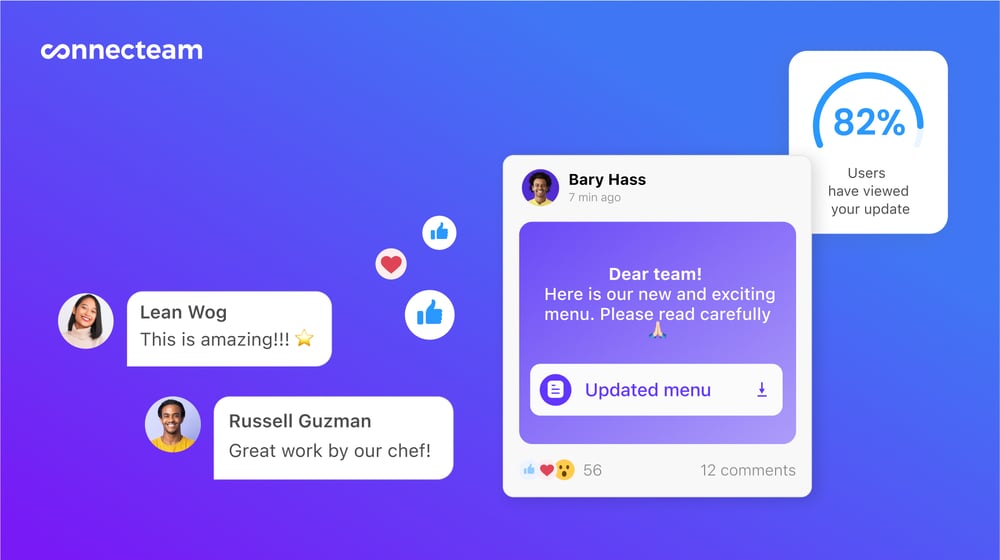
One central knowledge base
Connecteam makes it easy to build and maintain a company knowledge base. I liked that you can store everything in one place, including HR policies, employee handbooks, training materials, how-to guides, even client details. It’s all there, and it’s all easy to update and search.
I also appreciate the control it gives you. I can restrict downloads on sensitive files and make sure access is automatically revoked when someone leaves. That kind of built-in security really gives me peace of mind.
My favorite part about the knowledge base is Connecteam’s AI Agent. Instead of manually searching and hunting through documents, you can just ask a question in the chat (“What’s our PTO policy?”), and the AI Agent pulls a direct answer from your company’s knowledge base.
It’s like having your own ChatGPT customized to your business. What I love is that it saves time, especially for frontline teams, and it also saves managers from having to answer the same question repeatedly. If an employee wants to know something, they can just ask the AI Agent. It’s intuitive, clever, and a great way to stay aligned with company policies.
Smart company directory
Connecteam’s company employee directory makes it easy to find and contact coworkers. User profiles update automatically, so contact info stays current. You can search by name, title, department, or location and reach out via chat, email, or phone directly from the app.
For seasonal businesses or companies with temporary staff, the directory is a game-changer. There’s no need to save contacts to your personal phone, because everything’s stored in one place and easy to manage. You can archive or delete profiles when contracts end, keeping things clean, secure, and up to date.
I really like the option to set preferred contact hours. It’s a smart way to respect your team’s work/life balance, so you don’t bother someone outside of work hours.
You can also add external contacts (think: clients, vendors, or suppliers), so everything is in one place. Instead of employees asking for a vendor’s number, it’s already in the directory, ready for them to use. Admins can control who has access to the directory and even limit which contacts certain users can see to maintain privacy.
Built-in team chat
Connecteam’s online team chat makes it easy to communicate with individuals or start smart group chats for teams, departments, or projects. You can favorite conversations, mute conversations, and control who has access to what.
I like that the chat supports rich media (emojis, images, GIFs, videos), and you can customize push notifications so employees never miss an important update.
What I also appreciate is how secure it is. Chats are never stored on employees’ personal devices, so all communication and company data stays protected.
Plus, Connecteam’s AI Agent is built right into the chat. So if someone has a question, they can just ask, and get an instant answer based on company policies or SOPs.
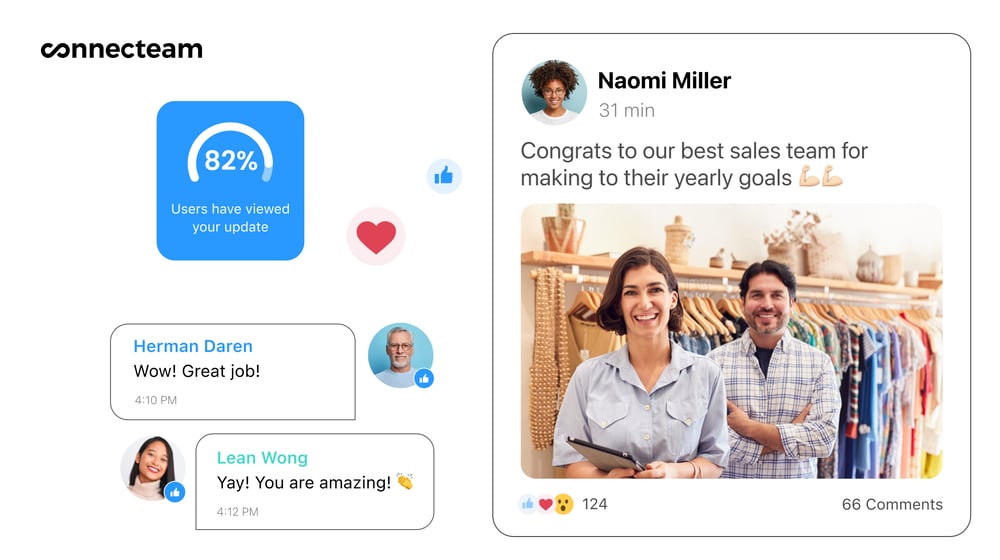
Company newsfeed
Connecteam’s company updates are built just like a newsfeed on social media, but for your business. You can post updates company-wide or target them by location, department, or job title.
I like how it makes it easy (and official) to share policy changes, welcome new hires, announce events, or post reminders. Team members can like and comment on posts, and you can even track who’s seen an update, so nothing slips through the cracks.
You can schedule posts, set auto-reminders, and customize notifications to make sure the right info reaches the right people at the right time. And since it’s available on mobile devices, your team can stay updated wherever they work.
Integrations
Connecteam offers an API plus integrations to connect with your existing workflows, including:
And so much more…
Connecteam offers more than just intranet software. Connecteam’s employee scheduler lets you build and assign shifts, track time, and manage availability from one place. With employee task tracking, you can make sure deadlines are met and monitor progress in real time. For training and onboarding, you can build custom courses to get new hires up to speed fast.
Key Features
- Knowledge base
- Company directory
- Built-in team chat
- AI Agent for easy search
- Company newsfeed
- Extensive access controls
Pros
- All-in-one platform
- User-friendly interface
- Mobile first design
- Highly customizable
Cons
- More integrations in development
Pricing
Free-for-life plan availablePremium plans start at $29/month for 30 users
14-day free trial, no credit card required
Start your free trial -

Simpplr — Good for AI-powered employee engagement
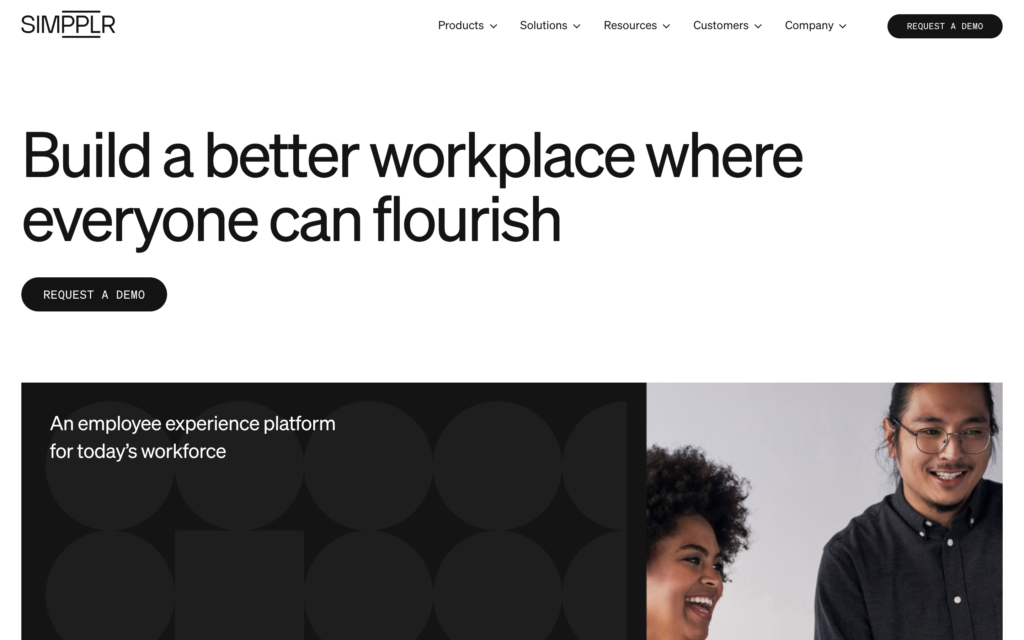
Simpplr is an employee engagement platform that is designed to connect and inform employees through smart communication tools and AI insights.
Why I chose Simpplr: I liked Simpplr for its organized design, and its focus on simplifying the employee experience through personalization.
Intranet and communication tools
Simpplr’s employee intranet is designed like a company dashboard, with a quick view of blogs, announcements, events, and helpful information. There’s a social-style newsfeed, which I liked for sharing company-wide updates. It was easy to post stories and documents, and I liked how clean the platform was. Searching for specific policies or updates was straightforward, but I didn’t like that employees have to search by file name because Simpplr doesn’t have a centralized folder system.
The lack of an in-app chat feature was a pretty big drawback for me. Without built-in messaging, you still have to use an external app, which can delay real-time communication.
Company newsletter
I liked the drag-and-drop newsletter builder. I found it easy to use and appreciated the different templates. The “smart blocks” made it quick to build, because they auto-fill the latest intranet content and add it directly to the newsletter.
You can send newsletters via email, Slack, or Microsoft Teams. However, I would have liked a way to schedule newsletters ahead of time or share newsletters directly to the newsfeed. Overall, the newsletter section felt like it was built to send out more corporate-style communication, rather than operational updates for smaller or field teams.
Employee engagement and feedback
Simpplr offers a few ways to gather employee feedback. I liked that there were both quick pulse surveys and longer-form custom questionnaires. There’s also a sentiment analysis feature that uses AI to detect engagement patterns, which I thought was a useful addition.
Simpplr’s employee recognition tools are a standout. You can create custom awards and give out redeemable points, which I liked. It was pretty basic, but it worked.
What surprised me was how limited the mobile app seemed to me. You can browse through content, but there was no way for admins to manage or publish directly from the app. I can see that being frustrating, especially for managers who are on the go and want to quickly update their team on something.
What users say about Simpplr
I like the customized homepage. It shows me news and updates that are unique to my work and location, so I’m not bombarded with stuff that doesn’t apply to me.
Simmplr appears to cater primarily to large companies with dedicated internal communications staff. As a small to mid-size nonprofit, we found that their implementation plan and onboarding support did not align with the realities of our workflow and the many, many different hats our staff wear.
Key Features
- Employee intranet
- Newsletters
- Surveys and feedback
- Employee recognition
Pros
- AI reporting
- Clean design
Cons
- No in-app chat
- No document library
Pricing
Contact vendor for price Trial: Yes — 14-day, by request only Free Plan: No
-

Unily — Good for large enterprises
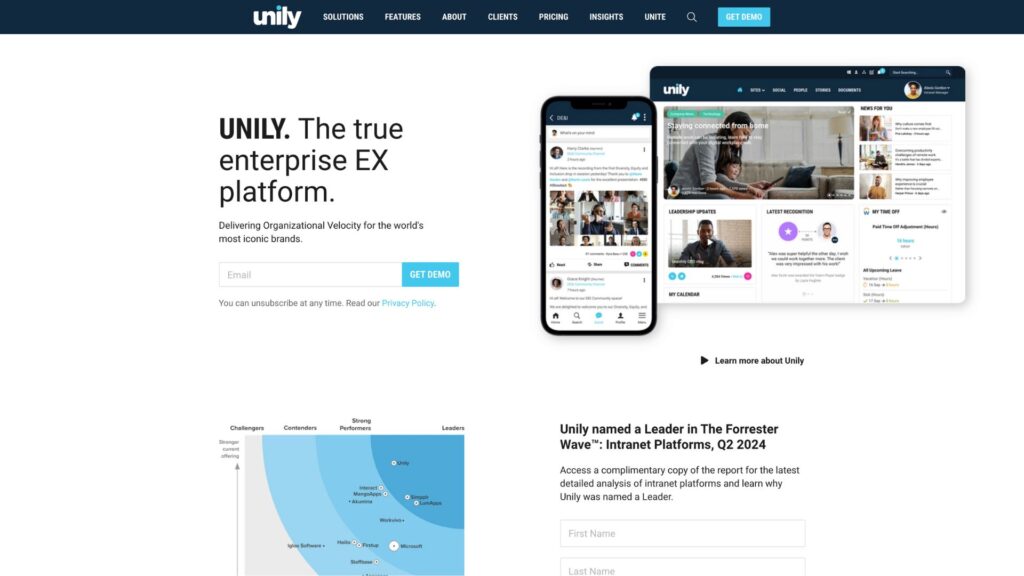
Unily is an online workplace platform designed for large, global teams that need a robust intranet and enterprise-grade integrations.
Why I chose Unily: I was impressed by Unily’s AI capabilities and how flexible the content management system was. I also appreciate the range of languages (40!) that it supports, great for multi-lingual teams.
AI-driven content management
Unily’s content creation tools were really strong. You can publish news updates, events, blog posts, and more using drag-and-drop templates and rich media options. I thought content scheduling was pretty simple, and I appreciated that everything looks pretty polished without much effort.
You can create and publish content in multiple languages using templates, media tools, and the AI editor. I liked how the platform personalizes each employee’s intranet experience, so they see relevant articles, videos, or updates based on their role, location, or interests. Users can react with emojis or comments, and Unily’s AI recommends content based on past engagement or location.
What I also liked was the strong access control features. Admins can moderate posts, auto-block flagged words, and manage who can view or publish content across different user roles or departments. While this level of governance is helpful, it feels like you’d need a dedicated communications professional or a small team to properly manage the platform.
Directory and social feed
With Unily’s social feed, you can share updates, post documents, and interact across departments. There are public and private channels, which I liked. I was also a fan of the people directory, which you can search by name, title, or skill. It makes it easy to find and contact the right colleague, even if you’re not sure what their role or name is.
I would have liked to see a messenger-style chat. While the platform handles announcements and social posts well, there’s no built-in option for real-time one-on-one or team conversations, which was a miss for me.
Employee experience tools
Unily has several tools to promote engagement and recognize employees. I thought it was an interesting idea to include an “ideation portal,” where team members can submit ideas and receive feedback and suggestions. There are pulse surveys that pop on users’ homepages with live results.
Recognition features are also built in, including kudos, custom badges, and awards. I liked that you can also set up employee journeys (like onboarding or upskillment) with clear steps employees need to take to grow.
What users say about Unily
I find Unily very easy to use once you have had some basic training, and the Unily team is excellent if you run into any questions or need support.
Although I was able to customize my home page, I felt there were some limitations when it came to customizing other aspects of the platform.
Key Features
- Content management system
- Social feed
- Communication channels
- People directory
Pros
- AI-powered content tools
- Many third-party integrations
Cons
- Platform designed for enterprises
- No built-in chat
Pricing
Contact vendor for price Trial: No Free Plan: No
-

MangoApps — Good for flexibility and customization
Available on
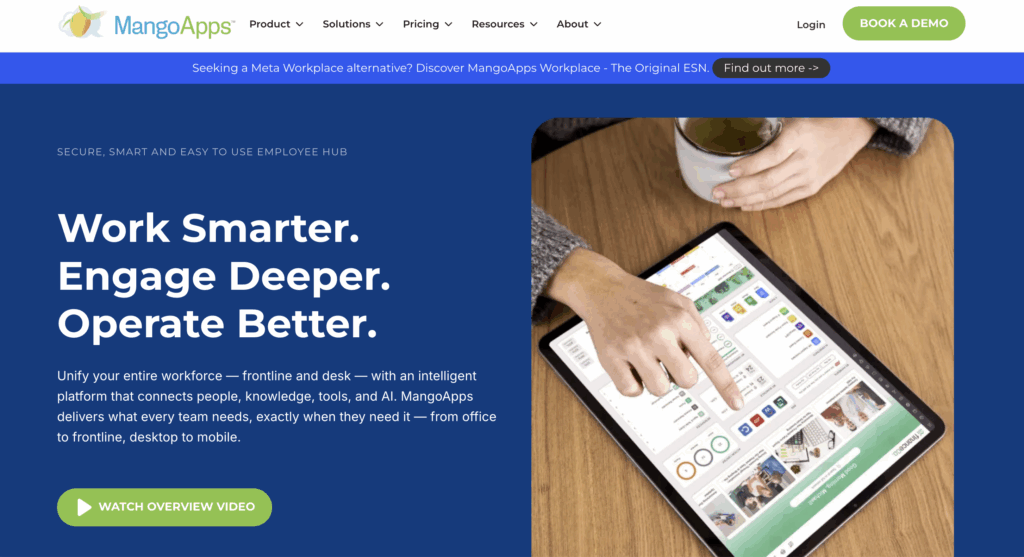
MangoApps is a highly customizable intranet platform designed to spark internal communication, collaboration, and knowledge sharing.
Why I chose MangoApps: I liked MangoApps because of its modular design and tailored setup. You can really customize the platform to suit your business.
Communication and workspace tools
When it comes to communication, MangoApps offers a work chat, team updates, and collaboration tools in one interface. I liked the real-time messaging and update feeds. They felt effective for keeping teams in the loop and were easy to locate within the platform.
One of the benefits of MangoApps is that it offers a modular approach. Meaning, I could choose which features I needed and wanted to see on my dashboard. It made it easy to keep information organized and reduce clutter.
Content management and directory
I liked MangoApps’ content management capabilities. I could create and organize internal documentation, knowledge bases, and announcements pretty easily. Plus, the AI-powered features helped personalize content delivery, showing employees relevant updates and resources based on their roles or preferences.
I found the employee directory to be pretty basic. It’s searchable by employee profile, but it seemed less developed than some competitors. Because MangoApps offers so many different features, I found that some seem more mature than others. This trade-off could be worth it for companies that are looking for MangoApps’ level of customization.
Integrations and Customization
I found that one of MangoApps’ biggest strengths is flexibility. It integrates with tools like Microsoft 365, Google Workspace, and Salesforce, which makes it simple to connect the intranet with your existing tools.
I also liked how much control I had over customization. making it easy to connect the intranet with existing systems. You can practically customize everything, from visual branding to feature layout. It’s a good fit for organizations that want their intranet to reflect their company identity.
What users say about MangoApps
MangoApps is easy to use, engaging, user-friendly, intuitive, and easy not navigate. It provides the perfect place for a collaborative work environment for a geographically diverse workforce.
The downside to having so many features is there are also so many things to learn and it can be overwhelming. Most of it is intuitive but still takes time to go through.
Key Features
- Company intranet
- Knowledge base
- Internal communication
- Employee directory
Pros
- Highly customizable
- Modular design
Cons
- Steep learning curve
- Limited mobile app
Pricing
Starts at $99/month for up to 25 users Trial: Yes Free Plan: No
-

Happeo — Good for knowledge management and content hubs
Available on
- Web
- iOS
- Android
- Windows
- Mac
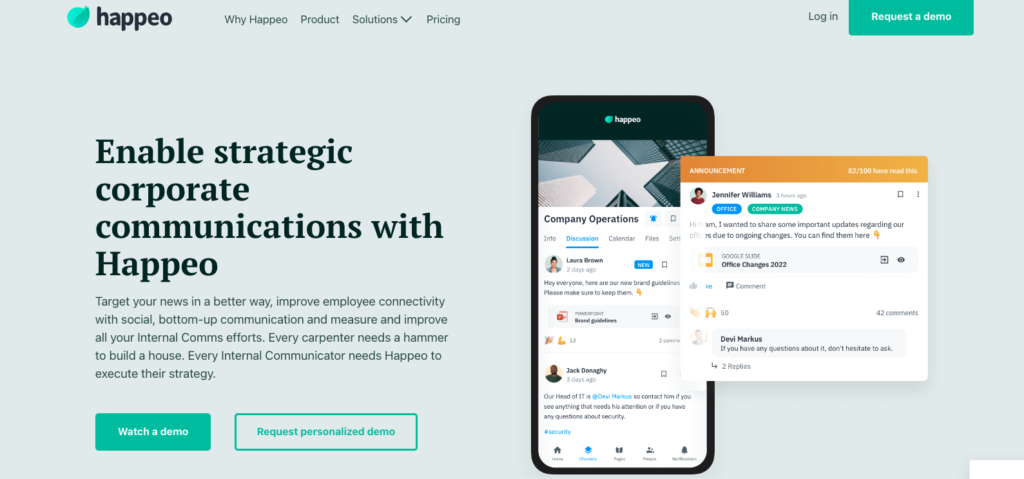
Happeo is an intranet software that focuses on knowledge sharing and team collaboration.
Why I chose Happeo: I liked Happeo because it offers strong knowledge management and search, ideal for distributed or remote teams.
Organized Knowledge Hubs with Page Templates
Happeo’s “Pages” feature lets you build hubs for documents, policies, guides, and other resources. I liked that it’s easy to organize and build pages. You can use a template or start from scratch, using the drag-and-drop editor. The template library isn’t as extensive as some competitors, but I liked that it covers common use cases, like company values and onboarding.
I also like the AI tools, which recommend images and text to help speed up the page setup. There are permission settings to limit control over who can view or edit each section. Employees can bookmark pages or search to easily find the information they need.
Group collaboration channels
Happeo’s “Channels” lets you segment communication by team, topic, or department. You can create public or private channels, limit posting or commenting, and customize the channel with links or shared files. I appreciated the control this gives managers, especially for handling company-wide announcements or sensitive updates.
I thought that posting was pretty simple. You can format messages, attach files, use emojis, or turn a regular post into an announcement. You can pin announcements and require employees to confirm that they’ve read them. I also liked that you can schedule posts in advance.
The biggest drawback for me is that Happeo doesn’t offer built-in direct messaging. You still need to rely on an external tool for one-on-one conversations.
Smart search and knowledge engine
I liked using the Knowledge Engine. It’s an AI-powered search that pulls from Pages, emails, chat messages, Drive files, and connected apps to return fast, relevant results. Plus, AI responses have a confidence score, so you can easily evaluate whether or not the answer is reliable without immediately going to the source.
In addition to fast answers, the platform can flag knowledge gaps when it doesn’t find reliable content, and notify content owners to fill them in, which I appreciated.
What users say about Happeo
That is very user friendly, its just like using facebook or instagram, our organization has improved the way we communicate and share the information, I like the layout and the way we can create channels and manage the information on the platform.
The lack of a scheduling tool is challenging; posts are made in real-time, and not able to be scheduled to launch at a specific time.
Key Features
- Knowledge base
- Communication channels
- Search functionality
- Access control
Pros
- User-friendly interface
- AI-powered search
Cons
- No one-on-one chats
- Extensive setup
Pricing
Contact vendor for price Trial: No Free Plan: No
Compare the Best Intranet Software
| Topic |
 Start for free
Start for free
|

|

|

|

|
|---|---|---|---|---|---|
| Reviews |
4.8
|
4.8
|
4.6
|
N/A
|
4.7
|
| Pricing |
Starts at just $29/month for the first 30 users
|
Contact vendor for price
|
Contact vendor for price
|
Starts at $99/month for up to 25 users
|
Contact vendor for price
|
| Free Trial |
yes
14-day
|
yes
14-day, by request only
|
no
|
yes
|
no
|
| Free Plan |
yes
Free Up to 10 users
|
no
|
no
|
no
|
no
|
| Use cases |
Best All-in-One Intranet Software
|
Good for AI-powered employee engagement
|
Good for large enterprises
|
Good for flexibility and customization
|
Good for knowledge management and content hubs
|
| Available on |
Web, iOS, Android, Windows, Mac
|
What Is Intranet Software?
Intranet software is a digital platform that businesses use to create a secure, private network for internal communication and collaboration. Only employees can access it, and it acts as the central place where teams can share updates, store important documents, and stay aligned.
Most intranet tools include features like company newsfeeds, document management, team chat, employee directories, and searchable knowledge bases. Businesses use intranet software to boost communication, improve access to information, and support a more connected company, especially for distributed or growing teams.
How Does Intranet Software Work?
Intranet software works by combining internal communication, content, and collaboration tools into one central platform. It typically runs in the cloud, so companies don’t need to manage their own servers, and employees can access it from desktop or mobile.
Admins and managers set up the structure, deciding which teams or departments can access different sections. They can assign permissions, schedule posts, organize content by category, and manage workflows through built-in tools.
Many platforms include company directories with employee contact information. These systems help make sure the right information reaches the right people.
The Benefits of Workplace Intranet Software
Intranet platforms can transform how your organization operates and communicates. Here are some of the benefits for your business:
Improved communication
Intranet software keeps teams connected with tools like group chats, private messaging, and company newsfeeds. Employees can stay up to date, and find the right information easily.
Enhanced collaboration
With shared access to documents, knowledge bases, and important updates, employees can collaborate smoothly. The right platform helps teams find what they need faster and work more efficiently.
A better sense of community
Employees can react to updates, reach out to colleagues, comment on posts, and take part in polls or social initiatives. This type of interaction builds a sense of belonging across the company, helping employees feel more connected.
Increased productivity
When there’s one central location for documents, updates, and contacts, employees spend less time searching and more time working. Intranet software reduces friction and speeds up workflows for increased productivity across the company.
Better employee engagement
The software improves communication, keeps employees informed, and helps workers feel like they’re heard. Being able to share feedback, stay updated, and join conversations can keep employees more engaged. Features like surveys and polls give employees a voice and make them feel heard.
Stronger data security
Most intranet platforms offer built-in security features like encryption, access control, and multi-factor authentication. This helps keep company and employee data secure, making sure only authorized people have access to sensitive content.
How Much Does Intranet Software Cost?
Most workplace intranet platforms use a per-user, per-month pricing model. On average, costs range from $4 to $8 per user, depending on the features offered. Some systems offer free trials, but full access usually requires a paid subscription. For larger businesses that need premium add-ons, pricing can quickly add up.
Connecteam offers more value for less. Connecteam’s Small Business Plan is completely free for up to 10 users, plus paid plans start at just $29 per month for up to 30 users.
FAQs
Connecteam is one of the best intranet platforms for businesses of all sizes. It’s easy to use, affordable, and has strong features for communication, document sharing, and employee management.
Businesses use software like Connecteam to build secure internal networks for communication, file sharing, and collaboration.
Yes, intranet software is more relevant than ever. Modern intranet platforms make it easier for teams to communicate, collaborate, and connect, especially in remote or hybrid work environments.
The Bottom Line on Intranet Software
A great intranet platform transforms how businesses communicate and access information. It gives employees a place to connect, receive updates, and collaborate.
More than that, the right intranet software can improve workplace productivity, streamline operations, and support a more engaged workforce. Connecteam stands out as the best option, offering powerful tools, simple setup, and pricing that makes sense for large enterprises and growing businesses.
Try Connecteam free for 14 days and see the difference for yourself.





